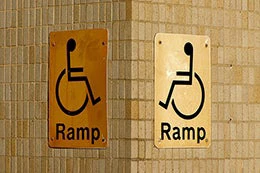 There is great diversity of needs among people with disabilities. Specific impairment may be linked to a physical, hearing, speech, visual or cognitive condition. And the reality is that almost everyone will face temporary or permanent disability at some point in life. This can be caused by a number of factors, ranging from disease, old age to accidents. The first
World Report on Disability, produced jointly by the World Health Organization (WHO) and the World Bank, suggests that more than a billion people in the world today have some form of disability.
There is great diversity of needs among people with disabilities. Specific impairment may be linked to a physical, hearing, speech, visual or cognitive condition. And the reality is that almost everyone will face temporary or permanent disability at some point in life. This can be caused by a number of factors, ranging from disease, old age to accidents. The first
World Report on Disability, produced jointly by the World Health Organization (WHO) and the World Bank, suggests that more than a billion people in the world today have some form of disability.
In all areas of life, personal mobility and accessibility allow people to reach and benefit from their environment. Regrettably, many obstacles and barriers to indoor and outdoor public facilities and buildings prevent equal access by people with disabilities as well as people who are not disabled but have limited mobility or physical challenges, including the elderly, children, and pregnant women.
In transportation, poorly accessible transport systems, infrastructure and vehicle design, as well as lack of accessible information to passengers hinder accessibility. This form of exclusion increases the costs associated with disability and people who are denied access to essential transport services tend to face greater challenges to stay out of, or exit, poverty.
Raising awareness and commitment for improving accessible transportation is needed from governments around the world. It is often perceived that accessibility is a luxury that cannot be afforded, and that universal access is unaffordable in the face of pressure to meet other priorities. However, significant gains can be made by just ensuring that good design principles that offer inclusion are properly observed when any infrastructure investments are being made. In most cases, adopting inclusive design principles requires planning and attention, not extra cost.
World Bank projects have shown that many countries have guidelines and standards for creating accessible transport systems. Guidelines regarding outdoor environments often include measures for space and width for wheelchair users, appropriate non-slippery firm surfaces, maximum gradients on ramps and curb stones, design of handrails, and visual and tactile markings for persons with impaired vision. In some countries appropriate designs for pedestrian crossings, including light poles and guiding technology for visually impaired persons, are included in standard street and road design documents. The UN Convention on the Rights of People with Disabilities also serves as a tool for engaging country counterparts in inclusive development policies and projects.
My recommendation for beginning to effectively address accessibility issues in transportation is to recognize that there is a continuum of interventions for making transport accessible that benefits all. It is critical to adopt universal design depending on the level of existing development and local circumstances. Likewise, the type of intervention needed can vary depending on the mode of transportation targeted. There could be an emphasis on developing accessibility of non-motorized mode of transport when such transport provides the greatest share of trips made. In other circumstances, features for buses should be emphasized due to their key role in providing the majority of trips for many passengers. Finally, it is important to review the entire trip chain that makes up a journey, from starting point to destination. If any link is inaccessible, the entire trip becomes difficult.
The lack of incentives and a perception that implementation is expensive, particularly for applying disability standards and solutions of high-income economies, should not stop the efforts to act now for achieving accessible transportation and universal mobility. I suggest reviewing some of our good practice experience and resources that have been developed through the commitment of our country clients and the pioneering leadership of our team leaders for purposeful inspiration.
Resources include:
- Statement from the World Bank Group at the UN high-level meeting of the General Assembly on Disability
- Improving Accessibility to Transport for People with Limited Mobility (PLM) - A Practical Guidance Note
- Accessibility and Transport
- Promoting Accessibility in Transport: Experience from the MENA region
- Accessibility of Urban Transport for People with Disabilities and Limited Mobility: Lessons from East Asia and the Pacific
- Analyzing access conditions in transport and urban environments for people with disability - the example of the Dakar Diamniadio toll highway project
- Bus Rapid Transit Accessibility Guidelines (English / Español)
Photo credit: Auntie P., 2007


Join the Conversation